The state of Florida was struck by three hurricanes in just under 12 months, from when Hurricane Ian blasted southwest Florida and water-logged Osceola County, Hurricane Nicole tried to mess up November, then Hurricane Idalia ravaged the Big Bend portion of the Gulf in August 2023.
The Sunshine State could be in store for more of the same–at least the opportunities for it–if the forecast from Dr. Philip Klotzbach and his team of tropical weather experts at Colorado State University comes true.
Their April forecast for the 2024 Atlantic hurricane season calls for 23 named storms and11 hurricanes, with five reaching Category 3 or higher major hurricane status. That’s the highest number of storms and hurricanes the CSU team has ever predicted in 40 years of making season forecasts. The statistical average of actual storms forming since 1995 has been 14-7-3.
And, in an example of, “One’s a coincidence, two’s a trend,” a week prior, AccuWeather, an American company that provides global weather forecasts, made an unnerving and potentially grim prediction of a possible hyperactive 2024 hurricane season–using the word “explosive”.
“The 2024 Atlantic hurricane season is forecast to feature well above the historical average number of tropical storms, hurricanes, major hurricanes and direct U.S. impacts,” AccuWeather Lead Hurricane Forecaster Alex DaSilva said.
AccuWeather meteorologists are forecasting 20-25 named storms across the Atlantic basin, including 8-12 hurricanes, four to seven major hurricanes and four to six direct U.S. impacts.
“There is a 10-15% chance of 30 or more named storms this year,” Da S i l v a said. The 2020 season featured a record 31 named storms. In 2005 and 2020, the list of 21 storm names (there are no ‘Q’, ‘U’ ‘X’ ‘Y’ or ‘Z’ storms) was exhausted and the Greek alphabet had to be employed. This year, the National Hurricane Center will use an auxiliary list of names rather than going Greek.
If the number of storms gets up into the 20s, that will be the case– but why?
Klotzbach says there’s two main components to the forecast: a current El Niño weather pattern that expected to shift to neutral by the start of the storm season, then to La Niña by the peak in August and September, and sea surface temperatures already at record warmth.
“La Niña typically increases Atlantic hurricane activity through decreases in vertical wind shear. This year’s sea surface temperatures in the eastern and central tropical Atlantic are much warmer than normal, also favoring an active Atlantic hurricane season via conditions that are conducive to developing hurricanes,” the CSU forecast said.
Tropical systems need warm ocean water, generally over 80 degrees, to form, develop and strengthen. Record-warm water temperatures in Atlantic, Caribbean and Gulf of Mexico are already there, and we’re just starting April.
“Pretty much the entire Atlantic is very warm right now,” Klotzbach said during an appearance at the National Tropical Weather Conference in South Padre Island, Texas. “So, unfortunately, I think there’s at least a little bit of, somewhat, that the die is cast for 2024.”
The season officially begins June 1, but five of the last seven seasons have featured a named storm forming in May or earlier. If the prediction of 23 pans out, which would be the third-busiest storm season And, keep in mind, it only takes one hurricane making landfall—an Irma or an Ian—to make it an active season for a community, regardless of how much activity is predicted. The Florida Legislature has again approved two 2024 sales-tax “holidays.” When consumers will not pay sales tax on disaster preparedness supplies ranging from batteries to portable generators. The first 14-day holiday will coincide with the start of hurricane season, and the second holiday is set for Aug. 24 through Sept. 6, just ahead of the historic peak of the season. So, get prepared like you always do, Osceola County— then keep a wary eye to the skies this summer.





